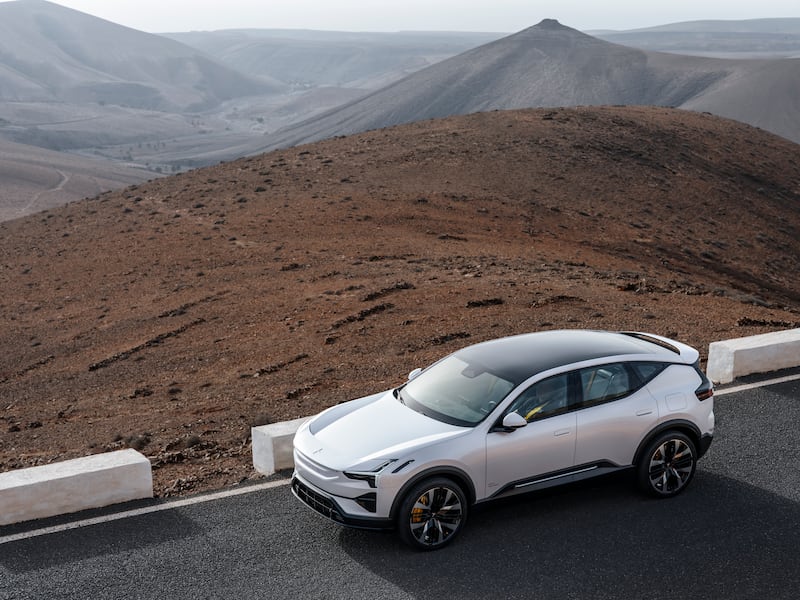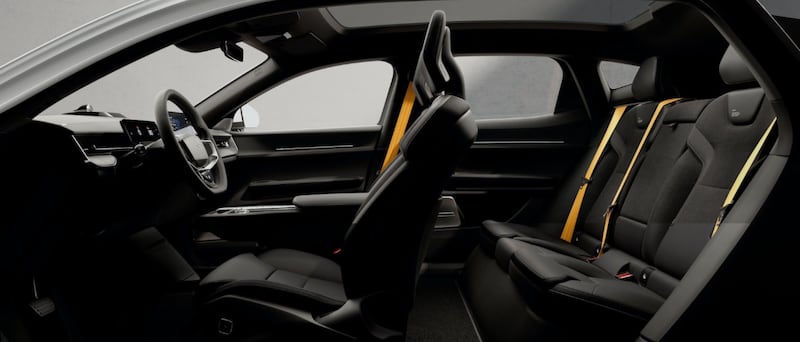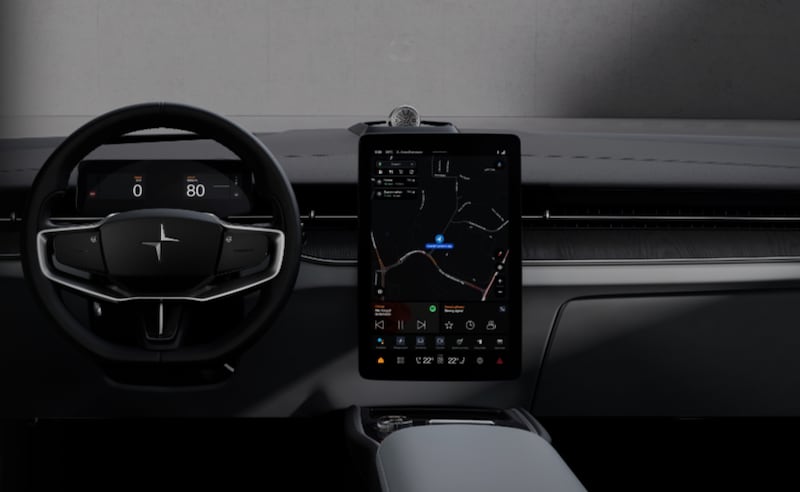Polestar has added a new all-electric SUV to its range. The sizeable Polestar 3 becomes the third model in the line-up of the premium electric offshoot from Volvo.
With a bandwagon of new brands arriving on the European car market this decade, particularly from China, Polestar is clearly eager to set out its stall and define itself on the market before the fleet lands.
Polestar is pushing two traits to differentiate itself from the rest of the traffic: design and driving performance.
Choosing as chief executive the former head designer for Volvo Thomas Ingenlath is a statement of intent on the design front. But pitching yourself as a direct rival to the likes of Porsche sets the bar incredibly high in terms of its models’ driving traits. Whether it lives up to the ambition on the road, we’ll have to wait for a drive.
READ MORE
First impressions of the new big SUV are impressive. And take my word for it, this car is big, measuring in at 4.9 metres long and tipping the scales at up to 2.7 tonnes. In terms of comparison, it’s similar in stature to the new BMW iX, long, sleek, though not as tall as many fully-fledged SUVs. It stands just over 1.6 metres tall, about the equivalent of a Mercedes-Benz GLC.

The new 3 is a step up from the 2, both in size and price. Tipping in at €100,000, this five-seater SUV is built on a new platform developed by Volvo to underpin its all-electric replacement for the XC90, due to be unveiled in the coming weeks. Given the importance of that model to Volvo, the decision to let Polestar get first crack at the important new platform tells how highly regarded the brand’s future is within its Chinese parent, Geely.
“This car has been designed as a Polestar from the start and features new defining characteristics for us – like the dual blade headlights, SmartZone and front aero wing,” says chief executive Thomas Ingenlath.

It might be a fully-fledged Polestar from the first day of planning, but it still retains strong Volvo roots.
At its heart the new Polestar 3 is a new platform developed by Volvo that will underpin several new models across both brands. While the exterior panels and interior mouldings may be Polestar, the rest is taken from Volvo.
Asked what parts of the car were unique to Polestar 3 and not shared with other brands within the Geely Group, Joakim Rydholm, Polestar’s chief chassis engineer. listed shock absorbers, bushels and tyres.
However, Ingenlath turned to a music analogy to defend the heavy link to the company parts bin. “A guitar is a guitar, but two musicians can produce very different music from it.”
The Polestar 3 is being launched with a dual-motor configuration and a power bias towards the rear. The standard car produces 489hp and 840 Nm of torque. With the optional Performance Pack, total output is increased to 517 hp and 910 Nm. That power means it can tow up to 2.2 tonnes, impressive for an electric luxury SUV and just what the well-heeled horsey set want to hear.
Advanced chassis control comes with air suspension as standard, allowing the driver to choose between comfort and dynamic suspension characteristics, while the car can adjust its active damper once every two milliseconds.
“Our goal was to offer the performance and precision that define all Polestar cars, without compromising the comfort of the daily drive,” says Rydholm. “To do this, we used new components like the adaptive air suspension to engineer the ‘Polestar feeling’ for this type of car.”
Air suspension is standard not only for ride quality but also for aerodynamic reasons. The ability to constantly adjust to conditions also allowed the designers to reduce the size of the air “wing” that feature on the front nose and the back roofline, says Nahum Escobedo, head of exterior design.


A 111kWh battery pack provides Polestar 3 with a claimed driving range of up to 610 km. A heat pump is included as standard and the car is also equipped for bidirectional charging, enabling future potential for vehicle-to-grid and plug-and-charge capabilities. Useful when electricity blackouts start to become a common occurrence.
The Polestar 3 also features a new centralised computing with the Nvidia Drive core computer, running software from Volvo Cars. Serving as the AI brain, it processes data from the car’s multiple sensors and cameras to enable advanced driver-assistance safety features and driver monitoring.
A total of five radar modules, five external cameras and twelve external ultrasonic sensors support numerous advanced safety features. The SmartZone below the front aero wing collects several of the forward-facing sensors, a heated radar module and camera, and now becomes a signature of Polestar design.
Inside, two closed-loop driver monitoring cameras bring leading eye tracking technology to Polestar for the first time. These cameras monitor the driver’s eyes and can trigger warning messages, sounds and even an emergency stop function when detecting a distracted, drowsy or disconnected driver.
As with Volvo, the in-car operating system fronted by the 14.5-inch centre display touchscreen works off Google’s Android Automotive OS. This is an evolution of the technology first launched in Polestar 2,and allows over-the-air (OTA) updates for continuous software improvement and the introduction of new features without the need to visit a garage - or service point as Polestar dubs them.
The cabin is sparse in terms of buttons, with almost all controls accommodated through the centre screen. Seating is more sports car than SUV and you tend to sit knee-high in both the front and back. Getting in and out is similarly more like a sports coupe than high-set SUV.
Along with the air suspension, other standard features include a full-length panoramic glass roof, LED lighting inside and out, retractable door handles with proximity sensing, and 21-inch alloy wheels.
The Plus Pack and Pilot Pack are fitted as standard for the first model year and include a raft of premium, luxury and convenience features like a 25-speaker audio system from Bowers & Wilkins with 3D surround sound and Dolby Atmos capability, soft-closing doors, a head-up display and Pilot Assist.
Available to order from the second quarter of 2023, the optional Pilot Pack with LiDAR from Luminar will add an additional control unit from NVIDIA, three cameras, four ultrasonic sensors and cleaning for the front- and rear-view cameras, providing accurate real-time data about the car’s surroundings especially in the long-range field. This enables enhanced 3D scanning of the car’s surroundings in greater detail and helps prepare the car for autonomous driving.
On the back of this new tech, Polestar executives plan in 2024 to be able to launch a version of unsupervised autonomous driving on highways in markets where such tech is legal.
The optional Performance Pack adds the additional power output mentioned before, plus performance optimisation for the air suspension, 22-inch forged alloy wheels and additional signature ‘Swedish gold’ details. However, for these added features - plus an extra 28hp and 70Nm of torque - acceleration from 0-100km/h improves by just 0.3 seconds. The cost is that you lose 30km in range and €7,000 of your hard-earned cash. Seems like a pretty pointless exercise.
Production for initial launch markets is planned to begin in Volvo Cars’ facility in Chengdu, China, from mid-2023, with first deliveries expected in the fourth quarter of next year. Production for the north American market will move to a new US production line in 2024.
“Polestar 3 is a powerful electric SUV that appeals to the senses with a distinct, Scandinavian design and excellent driving dynamics,” says Thomas Ingenlath, Polestar CEO. “It takes our manufacturing footprint to the next level, bringing Polestar production to the United States. We are proud and excited to expand our portfolio as we continue our rapid growth.”
While we never saw much of the Polestar 1 in Ireland, the Polestar 2 has made impressive headway in catching the attention of Irish premium buyers. It has been helped by the ever-growing buzz over all-electric cars, combined with the fact that Polestar says it isn’t suffering the same supply shortages as other premium rivals and can supply customers in a matter of weeks.
Polestar’s retail model seems a nice mix of the modern and tradition. Sales and interaction are online or through future “stores”, free of the haggling and hard-sell. Yet it also has the back-up of a traditional service network, courtesy of Volvo. It might portray itself as a David facing up against the established automotive goliaths, but in reality it has its own goliath watching its back.
While the Polestar 3 will win buyers in the most well-heeled suburbs, any real sales breakthrough will start next year, when the mid-sized Polestar 4 hits the market. It will be followed by a high-end all-electric sports coupe, the Polestar 5.
A new model each year for five years seemed an incredibly ambitious plan, but so far Polestar is on track.














